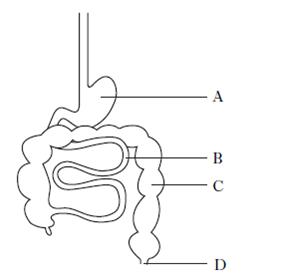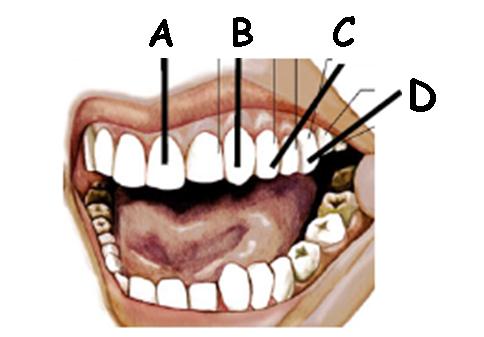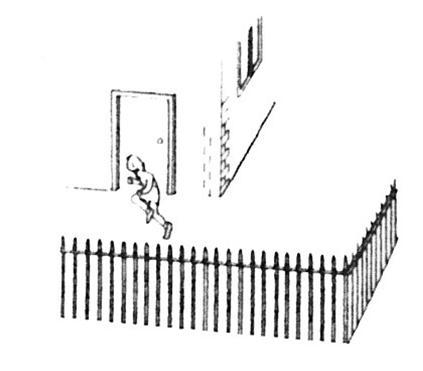| . 1 pt(s). |
The diagram below shows the human alimentary canal. What structure is the small intestine?
|
||
| A. | A | ||
| B. | B | ||
| C. | C | ||
| D. | D | ||
| 2. 1 pt(s). |
In the following diagram, which teeth are used to tear or grip food?
|
||
| A. | A | ||
| B. | B | ||
| C. | C | ||
| D. | D | ||
| 3. 1 pt(s). |
In which structure is water absorbed from?
|
||
| A. | A | ||
| B. | B | ||
| C. | C | ||
| D. | D | ||
| 4. 1 pt(s). |
Struture D is the
|
||
| A. | colon | ||
| B. | rectum | ||
| C. | anus | ||
| D. | small intestine | ||
| 5. 1 pt(s). |
Digestion is the process in which | |
| A. | small particles of food are made into large ones so that they can be absorbed in the small inestine | |
| B. | large particles of food are made into smaller ones so that they can be absorbed in the small intestine | |
| C. | small particles of food are made into large ones so that they can be absorbed in the stomach | |
| D. | large particles of food are made into smaller ones so that they can be absorbed in the stomach | |
| 6. 1 pt(s). |
The role of the small intestine is to | |
| A. | store waste | |
| B. | absorb water from waste | |
| C. | allow small food particles to pass into the bloodstream | |
| D. | churn the food with acid and other chemicals to break it down | |
| 7. 1 pt(s). |
The stomach | |
| A. | Stores waste | |
| B. | Allows the small food particles to pass into the | |
| C. | Absorbs water from waste (undigested food) | |
| D. | Churns the food with acid and other chemicals to break it | |
| 8. 1 pt(s). |
In the following diagram, which are the incisors?
|
||
| A. | A | ||
| B. | B | ||
| C. | C | ||
| D. | D | ||
| 9. 1 pt(s). |
During digestion food passes through a number of structures. Which of the following shows the correct order? | |
| A. | → | |
| B. | → | |
| C. | → | |
| D. | → | |
| 10. 1 pt(s). |
A girls pulse rate is 70 beats per minute. She runs around the school. What could her new pulse rate be?
|
||
| A. | 45 beats per minute | ||
| B. | 70 beats per minute | ||
| C. | 95 beats per minute | ||
| D. | 280 beats per minute | ||
| 11. 1 pt(s). |
Where does food pass through between the mouth and the stomach? | |
| A. | The gullet | |
| B. | The rectum | |
| C. | The small intestine | |
| D. | The large intestine | |
| 12. 1 pt(s). |
What happens when food reaches the stomach? | |
| A. | Nothing. No digestion occurs in the stomach. | |
| B. | The food moves quickly into the small intestine. | |
| C. | Juices mix with the food and stomach muscles squeeze it. | |
| D. | The food is completely digested and is absorbed by tiny blood vessels in the walls of the stomach. | |
| 13. 1 pt(s). |
Which of the following does NOT manufacture digestive juices? | |
| A. | Liver | |
| B. | Kidneys | |
| C. | Stomach | |
| D. | Pancreas | |
| 14. 1 pt(s). |
When a person breathes in | |
| A. | the diaphragm moves up and the ribs move down | |
| B. | the diaphragm moves down and the ribs move down | |
| C. | the diaphragm moves up and the ribs move up | |
| D. | the diaphragm moves down and the ribs move up | |
| 15. 1 pt(s). |
When we breathe out, the air passes through a number of structure to reach the air sacs. The order of structures it would pass through would be | |
| A. | mouth/ nose → trachea → bronchus → bronchiole → air sac | |
| B. | air sac → bronchus → bronchiole → trachea → mouth/ nose | |
| C. | air sac → bronchiole → bronchus → trachea → mouth/ nose | |
| D. | air sac → bronchiole → bronchus → oesophagus → mouth/ nose | |




